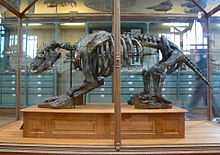Scelidotherium
Scelidotherium is an extinct genus of ground sloth of the family Mylodontidae, endemic to South America during the middle Pleistocene epoch. It lived from 780,000—11,000 years ago, existing for approximately 0.67 million years.[1]
It is characterized by an elongated, superficially anteater-like head. In fossil distribution, it is known almost exclusively from Argentina, but its distribution may have extended into Paraguay and Uruguay.
In his journal of The Voyage of the Beagle, Charles Darwin reports the finding of a nearly perfect fossil Scelidotherium in Punta Alta while travelling overland from Bahía Blanca to Buenos Aires in 1832. He allied it to the Megatherium. Owen (1840) recognized the true characters of the remains and named them Scelidotherium, which means "femur beast" to reflect the distinctive proportions of that skeletal element. They were 1.1 metres (3.6 ft) tall and might have weighed up to 2,700 kg (6,000 lb).[2]
Taxonomy
Scelidotherium was named by Owen (1839). It was assigned to Mylodontidae by Carroll (1988); and to Scelidotheriinae by Gaudin (1995) and Zurita et al. (2004).[3]
Additional images
| Front view of Scelidotherium leptocephalum skeleton |
| Scelidotherium cuvieri head |
| Scelidotherium sp. incomplete right hand |
|
References
- ↑ PaleoBiology Database: 'Scelidotherium, basic info
- ↑ Bargo, MS, SF Vizcaíno, FM Archuby, and RE Blanco. 2000. Limb bone proportions, strength and digging in some Lujanian (Late Pleistocene-Early Holocene) Mylodontid ground sloths (Mammalia, Xenarthra). Journal of Vertebrate Paleontology, 20(3):601-610
- ↑ R. L. Carroll. 1988. Vertebrate Paleontology and Evolution. W. H. Freeman and Company, New York 1-698
- Owen, R. (1840) Zoology of the Voyage of the Beagle1, Fossil Mammalia.


